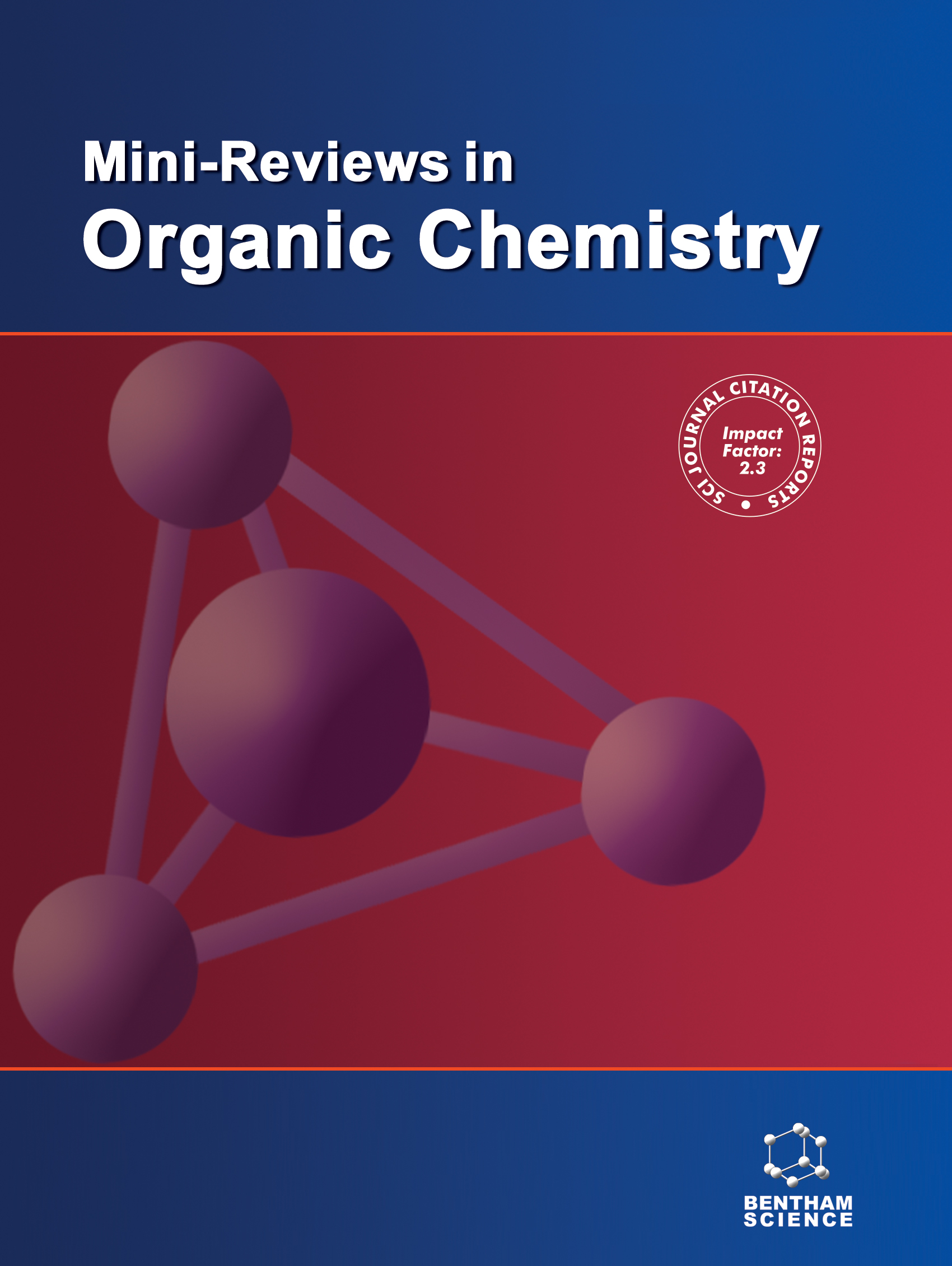Mini-Reviews in Organic Chemistry - Current Issue
Volume 22, Issue 8, 2025
-
-
Peptidomimetics as Emerging Inhibitor Against Mpro of SARS-CoV-2
More LessAuthors: Bibek Pramanik, Animesh Naskar, Totan Ghosh, Sashi Debnath and Krishnendu MajiSARS-CoV-2 infection was first spotted in Wuhan, China and rapidly spread over the globe, causing an emergency pandemic situation. COVID-19 infection affected 773,449,299 individuals, resulting in the unfortunate loss of 6,991,842 lives. Despite the rapid development of various vaccines, there remains a significant need for antiviral drugs to effectively lower the viral load. While Receptor Binding Domain (RBD) has been identified as a potential drug target against SARS-CoV-2, the main obstacle lies in the rapid mutation of the RBD in the spike protein. The main Protease (Mpro) of SARS-CoV-2 plays a crucial role in the replication of the virus and serves as a promising drug target due to its resistance to mutation. Peptidomimetics are excellent candidates to target the main protease through the covalent attachment with its active site, thus acting as a potential inhibitor against SARS-CoV-2. This review article includes the designed principles and inhibition mechanism of the reported peptidomimetics against Mpro of SARS-CoV-2.
-
-
-
Advances in Ru-based Organic Frameworks: Complex Organo-Ruthenium Structures in Medicinal Chemistry over the Last Decades
More LessAuthors: Jyoti Kuchhadiya, Atul Makasana and Khushal KapadiyaRuthenium and its complexes, or its nano form, are presently gaining a great deal of attention as essential reagents involved in lead discovery within the fields of medicinal, pharmacological, and biological chemistry. Similarly, as compared to systems made entirely of metal, nanoparticles have distinct and superior properties. As a powerful catalytic agent, ruthenium has several applications due to its inherent characteristics in both metallic and elemental forms. Arguably, ruthenium is the most important of the noble metals. From a variety of pharmacological perspectives, this review compiles the research on ruthenium and its complexes, highlighting their diversity and their potential beneficial effects in nanotechnology.
-
-
-
Recent Developments in the Synthesis, Reactions, and Biological Activities of Pyrimido[4,5-c] Isoquinolines from Pyrimidine Derivatives (Part II)
More LessIsoquinoline, quinoline, and pyrimidine are heterocyclic compounds with great potential for developing new drugs. When combined in isoquinoline-pyrimidine-inspired hybrids, they demonstrate numerous beneficial biological properties. Recently, many studies have focused on the synthesis and medicinal chemistry applications of pyrimido[4,5-c]isoquinoline ring systems (Py-isoQs4,5-c). This review offers a comprehensive overview of the synthesis of Py-isoQs4,5-c using pyrimidine, 6-amino-1,3-dimethyl-pyrimidine-dione, 6-amino-2-thioxopyrimidinone, 5-chloro-dimethylpyrimidin-4-amine, ethyl benzoate, cyclohexane-dione, cyclopentadiene, benzoquinone, naphthalene-dione, dihydronaphthalenone, isophthalonitrile, dihydroxybenzaldehyde, cyclo-heptanone, furan-methanol, dimethyl but-2-ynedioate, and their derivatives. These compounds are synthesized through various chemical reactions, including condensation, cyclocondensation, alkylation, substitution, one-pot three-component, cross-coupling, Vilsmeier, Suzuki–Miyaura, Diels-Alder reactions, and Pictet–Spengler reactions. These synthetic approaches allow for the efficient construction of Py-isoQs4,5-c, facilitating further exploration and investigation of their potential medicinal applications.
-
-
-
Recent Advances in the Chemistry of Oxadiazepine Derivatives: A Significant Leap in Synthetic Heterocycles and Biological Activity
More LessThe oxadiazepine moiety and its derivatives are crucial in developing new drugs. Combined with various compounds such as phthalazine, imidazole, pyrazole, indole, benzofuran, and thiazolopyrimidine, they exhibit beneficial biological properties. Recent studies have made significant progress in synthesizing oxadiazepine derivatives, enhancing our understanding of their potential medicinal applications. This review offers a comprehensive overview of these advancements, detailing the synthesis of various oxadiazepine derivatives and the chemical reactions involved. Here are some examples of the compounds discussed in this review: 3,6-di-nitro-1,3,6-oxadiazepane; 1,3,6-oxadiazepinodiphthalazine; 6-(1,3,6-oxadiazepane)-glycyl-L-alanine; benzoimidazo-1,3,6-oxadiazepine; azepino[1,2-c][1,3,6]oxadiazepine; dipyrazolo-1,3,6-oxadiazepine; sub-1,3,6-oxadiazepine-diindole; benzooxazino[3,4-b]benzo[5,6][1,4] oxazino[4,3-f][1,3,6]-oxadiazepine-6,8-diol and 2-(2-chloroethyl)-11-methyl-1,3,6-oxadiazepino[3,4-a]indole derivatives. These compounds are created through chemical reactions such as alkylation, condensation, cyclization, coupling, substitution, oxidation, reduction, multi-component reactions, intramolecular Mannich bases, and hydrolysis. Considering the significant biological activity of oxadiazepine derivatives, which are found in certain drugs such as staurosporine, these synthetic methods facilitate the efficient production of these compounds, thus encouraging further research into their potential pharmaceutical applications.
-
-
-
Synthetic Strategies of Imidazole Derivatives for Anticancer and Antimicrobial Agents: Comparative Studies
More LessAuthors: Areej M. Jaber and Mohammed M. Al-MahadeenImidazole, a versatile heterocyclic compound first discovered in 1858, has garnered significant attention for its wide range of pharmacological properties. The synthesis of imidazole derivatives has evolved through various innovative techniques, including condensation reactions, metal-catalyzed methods, and the use of nanoparticles as catalysts. Recent advancements, such as green chemistry approaches and microwave-assisted synthesis, have further highlighted its potential for sustainable and efficient drug development. Imidazole derivatives are known for their diverse therapeutic applications, including anticancer, antimicrobial, and anti-inflammatory activities. This review provides a comprehensive overview of the synthetic strategies for imidazole derivatives, emphasizing their historical significance, eco-friendly synthesis methods, and promising pharmacological properties. By exploring these advancements, we aim to underscore the critical role of imidazole in modern medicinal chemistry and its potential to inspire novel therapeutic solutions.
-
Volumes & issues
-
Volume 22 (2025)
-
Volume 21 (2024)
-
Volume 20 (2023)
-
Volume 19 (2022)
-
Volume 18 (2021)
-
Volume 17 (2020)
-
Volume 16 (2019)
-
Volume 15 (2018)
-
Volume 14 (2017)
-
Volume 13 (2016)
-
Volume 12 (2015)
-
Volume 11 (2014)
-
Volume 10 (2013)
-
Volume 9 (2012)
-
Volume 8 (2011)
-
Volume 7 (2010)
-
Volume 6 (2009)
-
Volume 5 (2008)
-
Volume 4 (2007)
-
Volume 3 (2006)
-
Volume 2 (2005)
-
Volume 1 (2004)
Most Read This Month Most Read RSS feed


